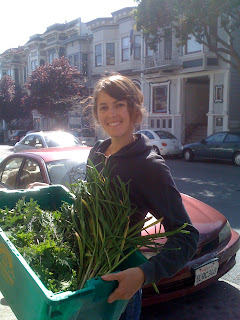Urban Gothic:

Lately, when Jessie and I talk about Amyitis, the subject that most often comes up is "what next?" It seems that for any bits of knowledge we'd gained from our days on the farm, we have
three times as much to learn. Every day we wonder what we could be doing that we haven't thought of yet, what is worth our energy and how much? Is our grow room good enough? Have we been over-fertilizing or under? What else is economical to grow for a restaurant? Just how much food are we expecting to yield this season? Is there a better way? What are we forgetting?
With each question we try to answer it seems that two more appear. With only a 1/2 season under our belt because of our late start last year, we're finding that there are questions that only time will answer for us. As uncomfortable as that is, until time passes we have to make the mistakes and choices like first timers. And let's face it, we are novices at this after all. With full time jobs, there is only so much time to hesitate. So we are doing what we know how one day at a time.
While we are waiting for mother nature to squeeze last drops out of winter from the clouds, we're doing our best to make plans for what is to come. But with all of our questions, we're both feeling a little less than efficient. It still feels too early to direct seed some things. We're not planning on planting many, if any, root veggies like carrots, beets, or potatoes because of the time and space it takes to grow them. So, naturally, we're a bit hesitant to direct seed squashes and cucumbers just yet because of their more sensitive nature. We have chard, lettuce and scallions hardening off under the cold frame that should be ready to hit the ground soon. For those that don't know, hardening off is the process of toughening up the plants between the greenhouse and the open field. Also, it is not too early for lettuce, peas and kale to go in, so they will get planted this week too.
In many ways it feels like the eye of the hurricane. The excitement of preparing our grow table building beds and ordering seeds has passed. And for now it appears that things have gone slightly idle. Yet at the same time, we both know that in a months time, we'll be too busy to think. So for now we're learning how to make the best use out of Mother Nature's limbo time: updating our business cards and trying to find more backyard spaces in the Mission! That being said, we're always looking for ways to find more usable spaces that are close to or in the Mission. Never hesitate to pass us along to a new reader or someone that might be interested in having their back yard space transformed into a producing, wholesaling micro-farm.
Much of what we are planting now will be going to the cozy kitchen of a brand new restaurant opening .....soon? ...here in the Mission called The Corner. Another venture of Peter Hood and Timothy Holt, The Corner will be a small-plate wine and espresso bar. Their menu will focus on local and seasonal meat, fish and produce from our Bay Area as well as fine wine and coffee. Amyitis greens will be a strong part of the menu as we give them a weekly harvest. We're very excited. It is a real privilege to see your food be magically transformed by inspired chefs. We can't wait. Be sure to keep eyes and ears open for news of the grand opening coming very soon.
Link of the Week:
Alemany Farm is a great local farm here in the city dedicated to growing community through growing food. If you are unfamiliar with
Alemany, be sure to go check out their website at
Alemany Farm. They provide meaningful youth and community activities at their multi-acre city farm and grow food for their low-income neighborhood.
Alemany's Mission Statement reads:
"Alemany Farm empowers San Francisco residents to grow their own food,
and through that process encourages people to become more engaged with their communities. We grow organic food and green jobs for low-income communities, while sowing the seeds for economic and environmental justice"
Huh... sounds a lot like us... but with loads more practice and expertise. We applaud the efforts and accomplishments of Alemany and encourage the growth of them and organizations like them. Like us here at Amyitis, they are always looking for volunteers. More information is listed on their website about how to be involved with them if you have something to learn or something to share.
Happy reading,
David























 Whooah
Whooah The Destination
The Destination Almost there
Almost there Proud ladies
Proud ladies Dirty Dirty Dillon
Dirty Dirty Dillon










